If you’re concerned that a child is writing their name backwards or mirror writing, please be reassured that in the majority of cases this is a common, even arguably normal occurrence. Also, it is something a large number of children do, and rarely a sign of any underlying issues.
What should you do if a child is writing letters backward?
If a child is just starting out with name writing, then it is perfectly normal to sometimes write letters backwards. If they are still reversing letters and writing their name backwards after some time, then try name writing in messy substances, sky writing, or writing over the top of dots.
First assess key information such as their age, and stage of development of their writing.
Children write in all sorts of directions – forwards, backwards, up, down, and diagonally.
Learning to write is a huge undertaking, and there are many abstract skills involved. Also, this happening at a time when their brains are rapidly developing.
There are many issues involved, but also there are lots of solutions in how to help children that are regularly writing their name backwards. This article will help give you as much background information as possible about why this is happening, and some positive action steps to take, if any are necessary.
Some of this information is taken from my bestselling book Squiggle, Fiddle, Splat – 101 Genius Fine Motor and Early Writing Activities (check it out on Amazon here).
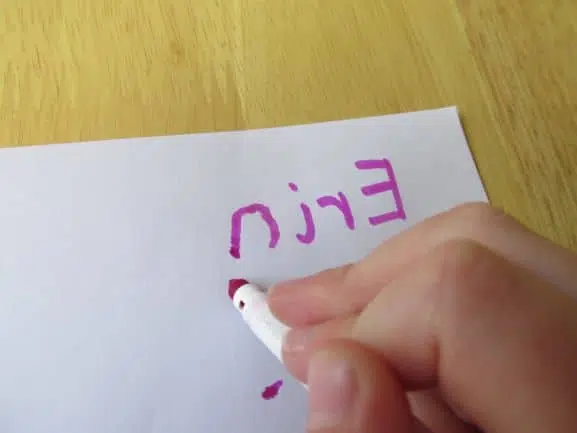
Why Children Write Their Names Backwards
There are several reasons why a large number of children will sometimes write letters or their names backwards. Often more than one reason will be taking place at any one time.
Some of the key reasons they’re reversing letters include:
Children’s Natural Brain Development
Children have a much less strong sense of left and right. Often by the time they begin writing, many children will not yet have decided upon which hand they will write with.

The positional concepts of left, right, and even up and down, take a long time to understand.
Abstract Nature Of Written Language
Learning to write involves a lot of abstract concepts.
The process of going left to right is one of them, and takes children a long time to get their heads around.
At the same time as trying to work this out, they are also battling with letter formation, thinking about the sounds of words, and thinking about breaking sentences up into words. There is so much going on when they’re trying to learn how to form letters!
Therefore it is very natural that some of the constructs (like left to right) occasionally go a little wrong and look like mirror writing.
Readiness To Write
Often children may be beginning to write before they are developmentally ready to do so. Our hands, in particular, go through a huge amount of change between birth and the ages of seven. We have many more bones in our hands at birth, many of which fuse during this period.
Also, children will often not have developed key gross and fine motor skills by this age.
This all makes the process of learning to write (and name writing) all the harder, and makes it much more likely that some things will sometimes go wrong.
Note – Of course a very small percentage of children that write their names backwards will later on be diagnosed with having dyslexia. However, these children will be in a tiny minority.
There will a lot more about this below.
- What are the 21 benefits of fine motor skills
- 16 amazing pipette activities for fine motor development
Some Common Examples Of Backwards Writing
Writing reverse letters or their names backwards is often just one (completely normal) sign of many that you will often see when young children write.
Some other common writing backwards examples are the following:
Reversals Of Letters
All children will do this at some point, although many will do it for longer.
Pretty much any letter can be reversed, with just a few exceptions (such as ‘o’). Many children will reverse the majority of letters for some time at least occasionally.
Also, there are some letters that almost always take longer to get right consistently, and will be a feature of many children’s writing.
The classic one of these is the letters ‘b’ and ‘d’. This is the biggie, but pretty much any other letter can be reversed.
Reversals Of Numbers
Often even children that have mastered writing letters in the correct formation will still occasionally take longer before they have stopped reversing some numbers.
Numbers are in many ways more difficult, as they are comprised of lots of straight lines, and there is not so much of a ‘flow’ in the same way the writing of letters flows.
Once again, reversing numbers really is not something to worry about.
One Sentence Forward, One Back
This is something that you will often see. A child will write the first line forwards, get to the end of the line, and keep going. They write the second line backwards from where the first line finished.
It is quite amazing how often their writing seems of a similar quality either forwards or backwards.
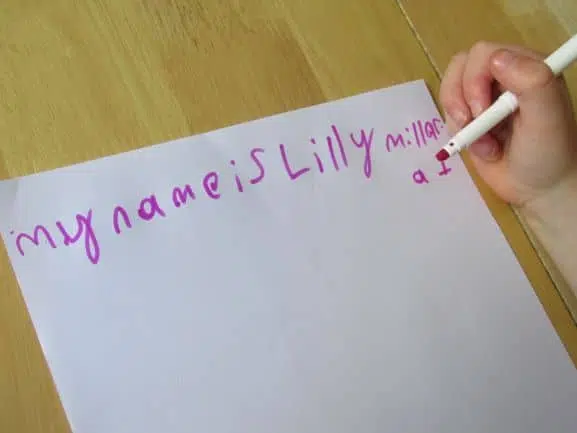
Writing Words Backwards
Often if a child is just writing one word somewhere they will write using reverse letters. This could be when they write what a picture is, for example.
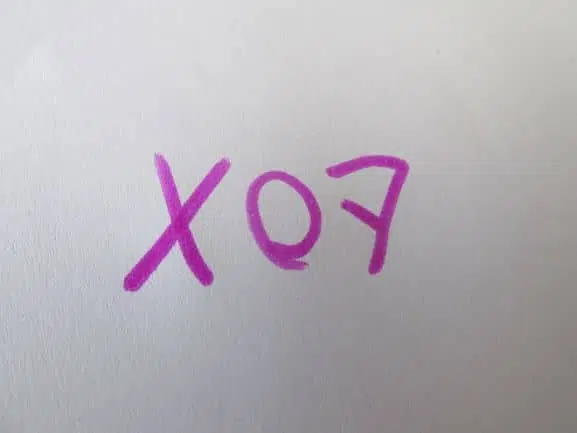
Writing Labels Backwards
It often happens even when children have mastered writing forwards, that sometimes there are situations where they revert to writing letters backwards.
One of these examples is writing labels for pieces of work. For example, they might have drawn a picture of a flower, and are going to label it with words like ‘petal’, ‘root’, ‘stem’, and all that kind of thing.
Often some of these labels will come out backwards! This is especially on the left hand side of the image. They will draw a line from the root, for example, that goes out to the left, then start writing ‘root’ from where the line ends – ie. From right to left (backwards). Pretty much any teacher that has tried an activity of labelling pictures can attest to this happening!
What To Do When They Write Their Name Backwards
The age and stage of writing of the child is crucial in determining what you do about it.
For example, if a child is only young (3-4 for example), and they are starting out with name writing, the important thing is to encourage them! Praise and positivity go a huge way in boosting children’s self confidence, and are one of the key areas you can motivate children as I explain in this article about the 15 best motivators for young children.
Getting them wanting to form letters and write is a massive step.
It may be best to just ignore it. At most, I would make a little joke out of it – ‘That looks a bit backwards to me!’ Try to avoid any mention that they have ‘done it wrong.’
A child’s name is often the first thing that they begin to write, so it is a massive achievement for them, and should be treated as such.
At the same time, it is good to support name writing the correct way by modelling it yourself, and using different games and strategies to get them writing it in the right direction.
Let’s go on to these ideas now to help them address mirror writing or any letter reversal issues they may have…
Strategies To Encourage Them To Write Forwards
So, this is the big thing – how do you encourage the child to write their name (or anything else) forwards? Here are some letter formation ideas:
Writing Name Specific Strategies
1. Writing Over Dots
One of the simplest ways to start out with name writing, is to write the child’s name on a card in dots. You then laminate the card.
They quite simply write their name over the top of the dots. Another way of doing this is with a yellow highlighter pen (check out the latest price on Amazon here).
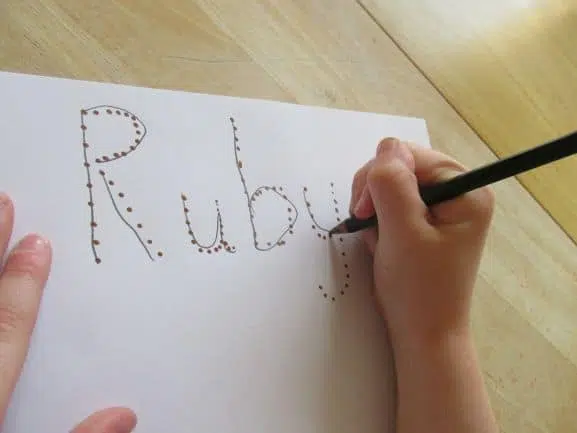
2. Copying Name Card
This is very simple – have a child’s name written on a card. Make sure you keep it somewhere where they can access it all the time.
Then, when they need to use it, the child gets the card and tries to copy the name. There is much less chance of going backwards if they are copying.
3. Writing In Messy Substances
Fun practice can really help with mirror writing or letter reversal!
Name writing in messy substances like gel or foam can help children enjoy the process and practise going in the correct direction.
4. Writing A Dot For Them To Start From
This is a very simple intervention for mirror writing and common letter reversals. This works when a child is writing their name independently (either forwards or backwards)
You quite simply write a dot on the paper where they are going to start their name. A good idea is put the dot very close to the left-hand side of the paper. This forces them to go to the right.
Writing Forwards In General
It is probably best to see backwards name writing as part of the bigger picture which is writing backwards in general.
Here are some good strategies for dealing with kids who are mirror writing or writing letters backwards:
1. Skywriting
Skywriting is using your finger, or something else like a ribbon or streamer, to write letters in the air. This is best done as a group activity. Model to the children how to write the letters, and get them to copy. The bigger the movements the better!
It is important that if you are facing the children you go the correct way. So if you face them directly, you will have to go backwards, as the children will copy you like a mirror. If you go right to left, they will go left to right. I hope this makes sense!
2. Having Chants And Sayings For Letters.
This is a particularly good strategy for the classic letter reversals – such as ‘b’ and ‘d’.
Making up fun chants can really help, such as ‘d starts with a c!’ This refers to the fact that you start writing a ‘d’ by first writing a ‘c’ that then develops into drawing a long vertical stick out of the ‘c’.
3. Active Writing Patterns
Writing patterns are lines such as zigzags, circles, squiggles, and other things like that. They are a great pre-cursor to writing letters.
By all having a go of writing these types of lines on big surfaces (such as wallpaper), you can really help children to practise going the right direction in a fun way.
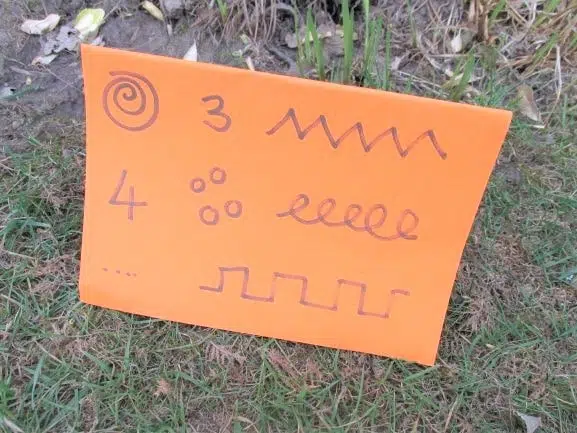
4. Pointing Out Reversals
This is more obvious, and a good thing to do as the children become more confident.
Basically, if you see a child making some kind of reversal, point it out and get them to correct it! The important thing is to do this in a spirit of support and encouragement.
Some Things To Know About Dyslexia
Of course, there will a small proportion of young children that make regular reversals that later on go on to be diagnosed with dyslexia.
However, you must understand that this percentage is only small.
In the majority of countries (certainly the US and UK), a diagnosis of dyslexia will never normally happen before the age of 7, and often it is later than this.
There are some other things that it is definitely worth knowing with regard to dyslexia and reversals in general:
Reversals Not Always Part Of Dyslexia
Some children have issues with reversals, but some don’t (Source).
There are some dyslexic children that don’t encounter issues with reversals, but just find problems with other areas such as spelling.
You Can Have Issues With Reversal Without Dyslexia
This is the other side of the coin. Many children will continue to have issues with reversals well beyond the age of seven. However, they do not have dyslexia.
This is normally caused by memory issues.
If you’re still concerned, a good place to look for answers to any of your questions is the International Dyslexia Association – https://dyslexiaida.org/
101 Activities Book
One of the most important things to focus on is getting children enjoying the process of early writing, and motivating them to keep going!
My book ‘Squiggle, Fiddle, Splat! 101 Fine Motor and Early Writing Activities,’ has now been read by thousands of parents and educators. It provides a full range of imaginative games and activities to inspire children and get them interacting positively with early writing.
You can check out my book on Amazon here:
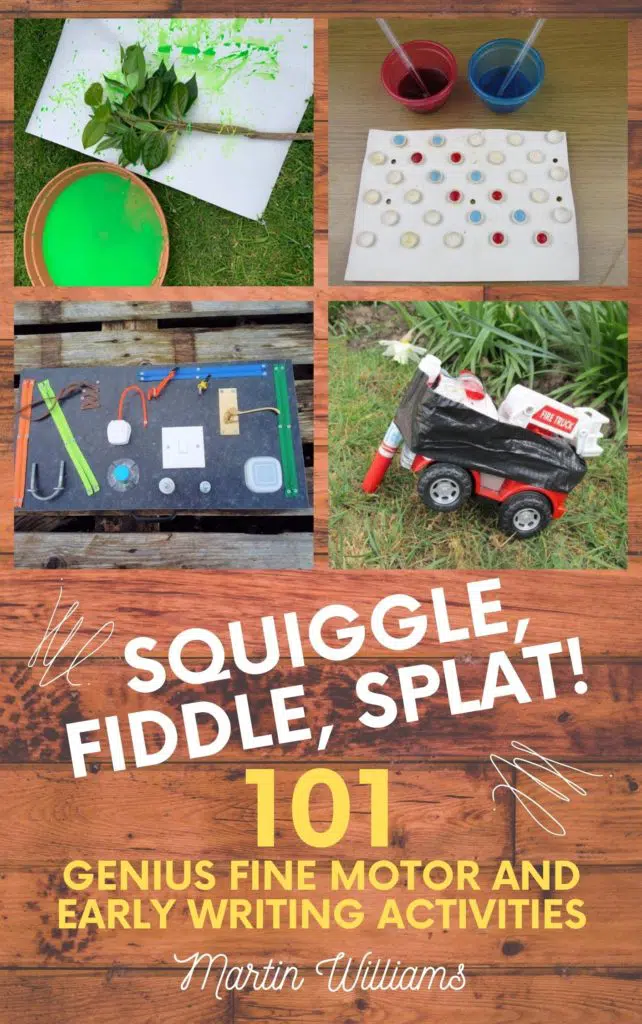
Conclusion
Reversing letters or writing letters backwards like names (and other things) is any extremely common thing.
When you see this happen it is important to be as positive and encouraging as you can. Practise active writing like skywriting, and support their writing in simple ways, and most children will learn to come out of this phase and effectively write from left to right for the rest of their lives.
If you’ve found this article useful, then why not check out one of these:
